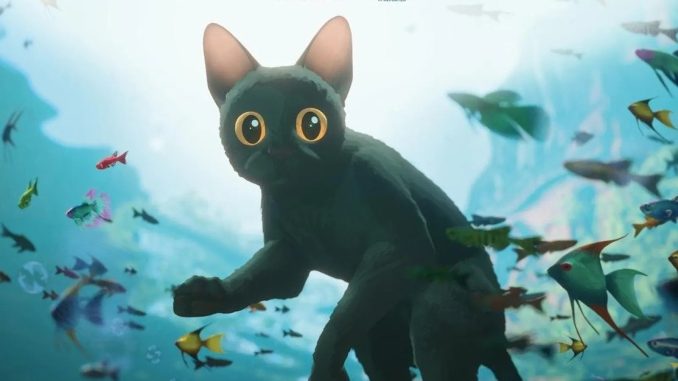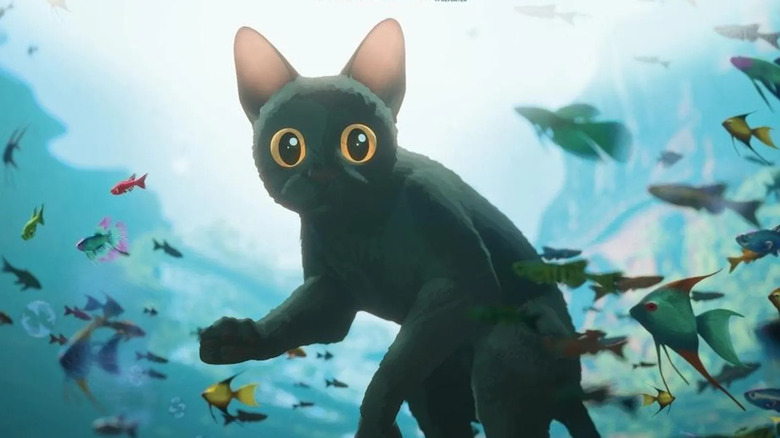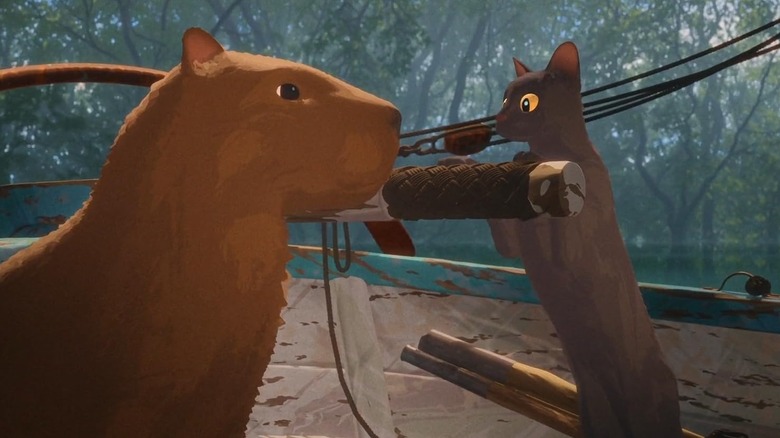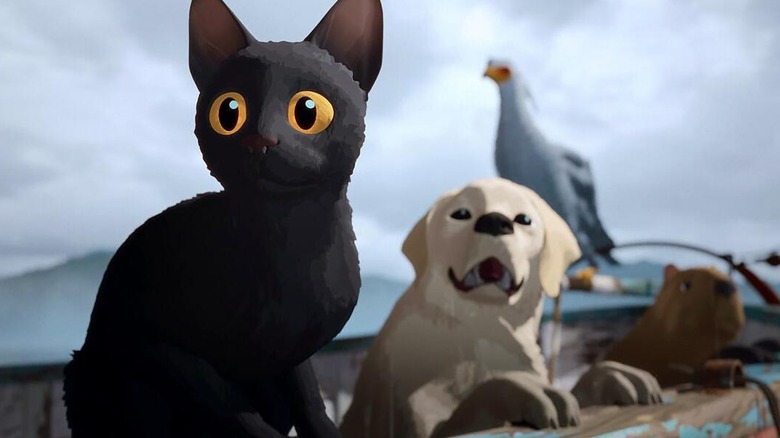
Max, the proprietary streamer for HBO and Discovery, has a ton of great films available to watch on the platform … but right now, an animated movie without any dialogue is one of its most-watched movies.
Directed and conceived by Gints Zilbalodis, “Flow,” an animated film that premiered at the Annecy Film Festival last summer and serves as a warning about the dangers of climate change, is an Oscar nominee for Best Animated Feature, and it’s also one of the most popular movies on Max at the moment (per FlixPatrol). While people might be seeking out the computer-animated, dreamy, and sometimes surreal film thanks to its Oscar nod, they’re probably pleasantly surprised by just how good it is. So, what is “Flow” (which Zilbalodis wrote alongside Matīss Kaža) about, and why doesn’t it have any dialogue?
Well, the simple and relatively flip answer about the dialogue thing is that animals can’t talk; obviously, a lot of animated movies ignore this real-life aspect, but “Flow” makes the interesting choice to keep its entirely non-human “cast” silent. The first character we meet is a black cat who encounters a pack of dogs fighting over fish in a forest stream, and after the area floods, the cat and a Labrador Retriever manage to escape and eventually end up on a boat with a capybara. A lemur joins them not long after and while they all try to move throughout a flooded world and rescue any other living beings they see, the animals unexpectedly bond. So, what do critics think of this innovative and aesthetically gorgeous film, and how has it already earned its place in movie history?
What have critics said about Flow?
Critics, unsurprisingly, really love “Flow.” With a 97% rating on Rotten Tomatoes as of this writing and a critical consensus that declares, “Thanks to its innovative animation and mature themes, going with this ‘Flow’ proves irresistible,” there are plenty of glowing, “certified fresh” reviews of Gints Zilbalodis’ award-winning film. “Latvia’s dark-horse entry in the animation Oscar sweeps doesn’t need dialogue (it has none) or A-list voices (also absent) to qualify as a thing of beauty as a cat and four fellow creatures carve out a future after a cataclysmic flood wipes out humanity,” Peter Travers raved for ABC News. Meanwhile, Ty Burr, reviewing the film for The Washington Post, called it “dreamy, epic, perilous, and very beautiful.”
FilmWeek‘s Amy Nicholson also praised the movie, writing, “What I felt watching this was the exhaustion and empathy about not being able to plan for the world that you’re living in […] On that ground, I thought it was beautiful.” (Apparently, her colleague Claudia Puig shared that sentiment; as she stated in her own review, “Flow” is “wondrous, gorgeously rendered, and immersive to the point where whenever the poor cat was imperiled I had a knot in my stomach.”) Kristy Puchko at Mashable was also a fan — as she put it, “Refusing to pander to its audience, ‘Flow’ is an animated adventure that is poignant, unique, absolutely gorgeous, and a must-see.”
Writing for Rolling Stone, David Fear got to the heart of the matter, explaining precisely why “Flow” is such a special animated film. “The real takeaway is that we have to rely on each other for salvation,” Fear wrote. “And it’s here where this experiential experiment in empathy, eco-activism and elation over the creative possibilities of a medium too often hijacked to sell toys truly hits its marks.”
Since its release, Flow has made cinematic history in a few ways
As I write this, the Academy Awards haven’t taken place yet, so we have no idea if “Flow” will win Best Animated Feature — but even still, it’s already won a handful of important accolades and set a few records for Latvia, the country that entered it into consideration for the Academy. It’s the first film from Latvia to win a Golden Globe — it edged out huge competitors like “The Wild Robot” and “Inside Out 2” during the January 5, 2025 ceremony — and according to a New York Times profile of Gints Zilbalodis that ran on February 12, it’s now one of the highest-grossing films in Latvian history. (“We beat James Cameron!” Zilbalodis crowed to interviewer Carlos Aguilar, referencing the fact that “Flow” has surpassed the “Avatar” movies in box office hauls specifically in Latvia.)
“Flow” is also the first Latvian movie to earn an Oscar nomination, and apparently, the country is going all out to celebrate the animated film. The Golden Globe that Zilbalodis accepted back in January is now on display at the Latvian National Museum of Art in the country’s capital city of Riga, and as Aguilar notes, it’s “guarded” by two cat statues. “It’s just a really nice boost of morale,” Zilbalodis told Aguilar of the award being displayed. “People are tired of bad news and maybe this film represents something that feels optimistic and hopeful in regard to the country’s self-esteem.” Not only that, but according to a post on X (formerly known as Twitter) from Zilbalodis himself, a statue of the cat from “Flow” also adorns a statue that spells out “Riga” in the capital now.
“There’s real appetite for films like this, that gives me a lot of hope,” Zilbadolis told Aguilar before expressing one final hope: “People around the world who might not have heard about Latvia will now have heard about it.” Now that “Flow” is available to stream on Max (and considering just how many people are watching it), he may just get his wish.




Leave a Reply